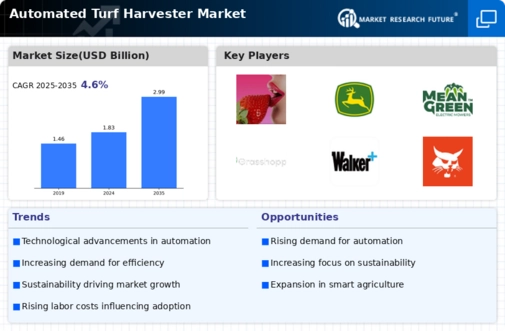Global Expansion of Sports Facilities
The expansion of sports facilities worldwide is significantly impacting the Global Automated Turf Harvester Market Industry. As new stadiums and recreational areas are developed, the demand for high-quality turf increases. Automated turf harvesters provide an efficient means of maintaining these surfaces, ensuring optimal playing conditions. This trend is particularly evident in regions investing heavily in sports infrastructure, where the need for reliable turf management solutions is paramount. The market's growth is likely to be fueled by this expansion, with stakeholders recognizing the value of automation in maintaining high standards for turf quality and performance.
Rising Popularity of Turf in Landscaping
The Global Automated Turf Harvester Market Industry is benefiting from the rising popularity of turf in landscaping and recreational areas. As urbanization increases, the demand for aesthetically pleasing green spaces grows, leading to higher turf production. Automated harvesters facilitate the efficient management of these turf areas, allowing for quicker and more effective harvesting processes. This trend is particularly pronounced in urban environments where landscaping is essential for enhancing property values. The market's growth trajectory suggests that as more municipalities and private entities invest in green spaces, the demand for automated turf harvesting solutions will continue to rise.
Technological Advancements in Automation
Technological advancements play a crucial role in shaping the Global Automated Turf Harvester Market Industry. Innovations in sensor technology, machine learning, and data analytics are enhancing the capabilities of automated harvesters. These advancements enable more precise operations, leading to improved yield and reduced resource consumption. As these technologies become more accessible, the market is likely to experience accelerated growth. The anticipated compound annual growth rate of 4.57% from 2025 to 2035 indicates a robust future for the industry. Manufacturers are increasingly investing in research and development to integrate cutting-edge technologies into their products, ensuring competitiveness in a rapidly evolving market.
Increasing Demand for Automated Solutions
The Global Automated Turf Harvester Market Industry is witnessing a surge in demand for automated solutions due to the growing need for efficiency in turf management. As labor costs rise and the availability of skilled labor diminishes, automated harvesters offer a viable alternative. In 2024, the market is projected to reach 1.83 USD Billion, reflecting a shift towards mechanization in agriculture. This trend is particularly evident in regions with extensive turf production, where automation can significantly reduce operational costs and enhance productivity. The adoption of these technologies is likely to continue, driven by advancements in robotics and artificial intelligence.
Sustainability and Environmental Considerations
Sustainability concerns are increasingly influencing the Global Automated Turf Harvester Market Industry. As environmental regulations tighten, the demand for eco-friendly harvesting solutions rises. Automated turf harvesters, which often utilize precision agriculture techniques, can minimize waste and reduce chemical usage, aligning with sustainable practices. This shift is particularly relevant in regions where environmental stewardship is prioritized. The market's growth is expected to be bolstered by the increasing emphasis on sustainable agriculture, with projections indicating a rise to 2.99 USD Billion by 2035. This trend suggests that manufacturers will need to innovate continually to meet both market demands and regulatory requirements.

























Leave a Comment